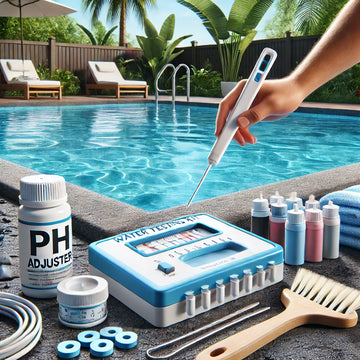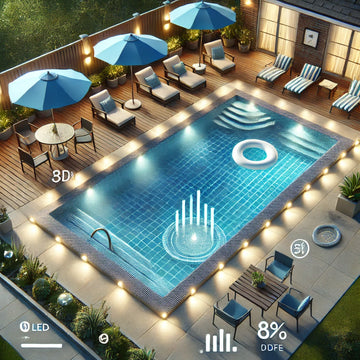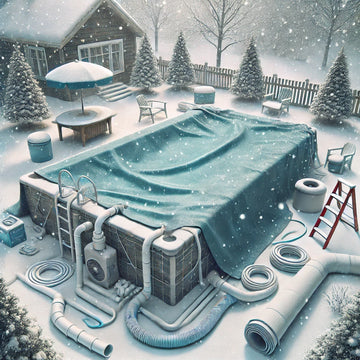It’s All About Balance
Getting a pool is very exciting. It can transform your summer experience for years to come. But pools do require a lot of maintenance. Proper maintenance to maintain the health of your pool is of the utmost importance. It’s a significant investment and one that you want to be meticulous about caring for.
In this article, we’ll explore tips and tricks on balancing your pool water. An important factor in the regular maintenance of your pool.
Want to learn more?
Check out our pool balancing series!
What You Will Need
Below, we get into what is required to balance your pool and ensure that your water remains safe and clean for you to swim in.
Water Testing Kit
If you want to determine the balance of chemicals in your water, you will need to get a water testing kit. They can be purchased at your local pool supplier’s and are an easy way to determine what might be needed to adjust the balance in your pool water.
Alkalinity Balancer
When the pH level in your pool exceeds 7.8 pH, your water is considered to have high pH. This means that your water is now too soft, which can have consequences. Additional chlorine stabilizers and sudden increases in temperatures can also cause issues. Physical consequences are also a concern of high pH for swimmers. Red, irritable eyes, dry skin and premature wear and tear of goggles and bathing suits are often indicative of a high pH level. Low pH can also become an issue for swimmers, pool and wallets. Acidic water is corrosive. Stinging eyes, nasal passages and dry skin and hair can all be symptoms of low pH. It can also cause etching and deterioration of plaster, grout, stone, concrete, vinyl liners and tiling.
Water Hardness Balancer
Hardness in water consists of both calcium and magnesium salts. Only the calcium component is relevant in the water balance calculation for pools. When the SI value is zero (also know as the Langelier Saturation Index), the water is properly balanced. It means its calcium hardness, pH and alkalinity are acting in harmony with one another. Anything more than +0.5, you are trending towards scaling, and conditions are right for calcium carbonate to deposit on surfaces as “scale.”
Stabilizer or Conditioner
Conditioner should only be added after properly testing its level. Once a proper test and analysis are done, you can determine if a stabilizer is needed. You can bring a quart of your pool water in as a sample for your local pool expert to test and analyze for you, which may just save you money in the end.
Chlorine Tablets
Chlorine tablets are an easy-to-use way to dispense chlorine at a steady rate, rather than tossing scoops of chlorine granules into a pool. The chlorine concentration of your swimming pool should be at least 1 part per million (ppm) and not go above 3 ppm. Regular water testing is essential to determine whether or not your pool contains the right amount of sanitizer.
How Do You Balance Pool Water?
If you’re new to swimming pool maintenance, testing and balancing the chemicals can be an overwhelming process. There is a learning curve to water care, as with anything else, but it’s not a steep curve.
Below, we list each step to testing and balancing your pool water to help you avoid problems in the future.
Test for pH Balance
Anything below 7.0 represents an acidic condition (low pH), while a level above 7.0 represents an alkaline condition (high pH). Depending on your readings, you will want to add either a pH increaser or pH decreaser. Keeping your pH properly balanced is important because an imbalance can cause structural and equipment damage.
Test for Alkalinity
The ideal range for total alkalinity is 80-120 ppm. Depending on your readings, you will want to add either an alkalinity increaser to increase the alkalinity or a sodium bisulphate to decrease alkalinity.
Test for Calcium Hardness
The next step deals with water hardness. Calcium hardness refers to the amount of minerals, in this case, calcium, which is present in the water. The ideal range for calcium hardness is 200-400 ppm. To raise calcium hardness, you will want to use calcium chloride. If you are experiencing high calcium hardness levels, you will either have to drain the pool completely or partially and refill with fresh water—something you most likely want to avoid at all costs.
Test for Cyanuric Acid
CYA is sold as either a pool stabilizer or pool conditioner. Cyanuric acid helps protect chlorine from being destroyed by the sun’s ultraviolet rays, so it’s an essential ingredient. Its level should be in the 30-50 ppm range.
Test for Chlorine
Chlorine is used as a sanitizer or disinfectant to kill bacteria, living organisms, ammonia and other contaminants in the pool. Your levels should be within the 2.0-4.0 range.
Check Your Pool Temperature
Temperature can have an impact on how your balancing components work together. Keep your pool at a consistent temperature to ensure that your chemical balance is working for you. Different temperatures mean possibly having to use less or more chemicals.
Finding the Perfect Balance is An Art
The process of pool balancing is an important one. One that can significantly impact the life of your pool and its condition. Improper balancing can wreak havoc on your investment, leading to significant costs and damage, on top of irritating those who use it, physically. Ensure that you are properly maintaining your pool to continue enjoying it for many years to come. At HB Pools, we can help with maintenance and tips to ensure that your water remains balanced.




